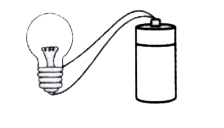A wire connected to a bulb does not glow, whereas the filament of the bulb gilows when same current flows through them. Why?
Video Solution
Text Solution
Filament of bulb and supply wires are connected in series. Therefore, the same current flows through them. Since the resistance of connecting wires is negligibly small as compared to the resistance of filament and heat produced due to given current is directly proportional to its resistance (from Joule's law of heating), therefore, the heat produced in the filament is vey large. Hence the bulb glows, but the connecting wirs remain pratically unheated.
|
Topper's Solved these Questions
- CURRENT ELECTRICITYBook:PRADEEPChapter:CURRENT ELECTRICITYExercise:Conceptual Problems
Explore 3 Videos
- CURRENT ELECTRICITYBook:PRADEEPChapter:CURRENT ELECTRICITYExercise:Very short Q/A
Explore 7 Videos
- COMMUNICATION SYSTEMSBook:PRADEEPChapter:COMMUNICATION SYSTEMSExercise:MODEL TEST PAPER-2
Explore 9 Videos
- DUAL NATURE OF RADIATION AND MATTERBook:PRADEEPChapter:DUAL NATURE OF RADIATION AND MATTERExercise:Exercise
Explore 191 Videos
Similar Questions
Knowledge Check
In which case does the bulb glow ?
A B
B C
C D
D
A bulb is connected to a cell and the potential differ-ence across the terminals of the bulb is 24 V. If 3 A of current flows through the bulb, then the resitance of its filament is _____ω.
A8B72C24D3What is the thin wire In the bulb which glows when an electric current passes through It called?
AFilamentBHolderCConnecting wireDElement
When bulbs are connected in series, same current flows through them.
View SolutionWhy does an electric bulb does not glow even it is connected to the cell ?
View SolutionDraw wires to connet the bulb to the battery so that the bulb glows with maximum brightness.

View SolutionWhen an electric bulb glows
View SolutionThe filament of an electric bulb is made of a thin wire of :
View Solution

